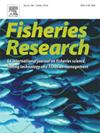Derivation of a standardized index to explore spatial, seasonal and between-year variation of squid (Loligo spp.) abundance in the English Channel
IF 2.2
2区 农林科学
Q2 FISHERIES
引用次数: 0
Abstract
Long-finned squids are among the valuable resources exploited by English Channel demersal fisheries. This resource consists of two short-lived species (not distinguished in landings): Loligo forbesii and Loligo vulgaris, which differ in the timing of their life cycle. In the present study, we investigated spatial, seasonal and long-term biomass variation of Loligo spp. in the English Channel using 22 years (2000–2021) of commercial fishing data to compute biomass indices. Results indicated that landing per unit of effort (LPUE) indices (computed per month for each statistical rectangle of the English Channel), standardized by vector autoregressive spatio-temporal (VAST) method, provided an appropriate squid biomass estimator. Two distinct geographical patterns were observed in the English Channel, with low and stable biomass indices in the West and most of the fluctuations and seasonal variations in East. Within each year, the observed increase in abundance in June is likely to correspond to the recruitment of the loliginid squid into the fishery. Abundance typically rises from June to December and then gradually decreases from January to May. Over the 22-year series there has been an eastward shift in squid biomass since 2014. This information is valuable for fishers but also to manage fisheries, as it offers potential indices of squid availability to the fisheries and a direct quantification of loliginid biomass variability in the ecosystem.
推导标准化指数以探索英吉利海峡鱿鱼(Loligo spp.)丰度的空间、季节和年际变化
长鳍鱿鱼是英吉利海峡海底渔业开发的宝贵资源之一。该资源由两种短命物种组成(未在登陆中区分):Loligo forbesii和Loligo vulgaris,它们的生命周期时间不同。利用2000-2021年22年的商业捕捞数据,对英吉利海峡Loligo spp.生物量的空间、季节和长期变化进行了研究。结果表明,采用向量自回归时空(VAST)方法对英吉利海峡每个统计矩形每月计算的单位努力着陆量(LPUE)指数进行标准化,可以提供一个合适的鱿鱼生物量估计。在英吉利海峡观察到两种截然不同的地理格局,西部的生物量指数低而稳定,东部的波动和季节变化最多。在每年的6月,观察到的丰度增加可能对应于低脂鱿鱼进入渔业的招募。丰度通常从6月到12月上升,然后从1月到5月逐渐下降。自2014年以来,在22年的系列中,鱿鱼生物量向东转移。这些信息不仅对渔民有价值,而且对渔业管理也有价值,因为它为渔业提供了鱿鱼可用性的潜在指数,并直接量化了生态系统中脂质生物量的变化。
本文章由计算机程序翻译,如有差异,请以英文原文为准。
求助全文
约1分钟内获得全文
求助全文
来源期刊

Fisheries Research
农林科学-渔业
CiteScore
4.50
自引率
16.70%
发文量
294
审稿时长
15 weeks
期刊介绍:
This journal provides an international forum for the publication of papers in the areas of fisheries science, fishing technology, fisheries management and relevant socio-economics. The scope covers fisheries in salt, brackish and freshwater systems, and all aspects of associated ecology, environmental aspects of fisheries, and economics. Both theoretical and practical papers are acceptable, including laboratory and field experimental studies relevant to fisheries. Papers on the conservation of exploitable living resources are welcome. Review and Viewpoint articles are also published. As the specified areas inevitably impinge on and interrelate with each other, the approach of the journal is multidisciplinary, and authors are encouraged to emphasise the relevance of their own work to that of other disciplines. The journal is intended for fisheries scientists, biological oceanographers, gear technologists, economists, managers, administrators, policy makers and legislators.
 求助内容:
求助内容: 应助结果提醒方式:
应助结果提醒方式:


